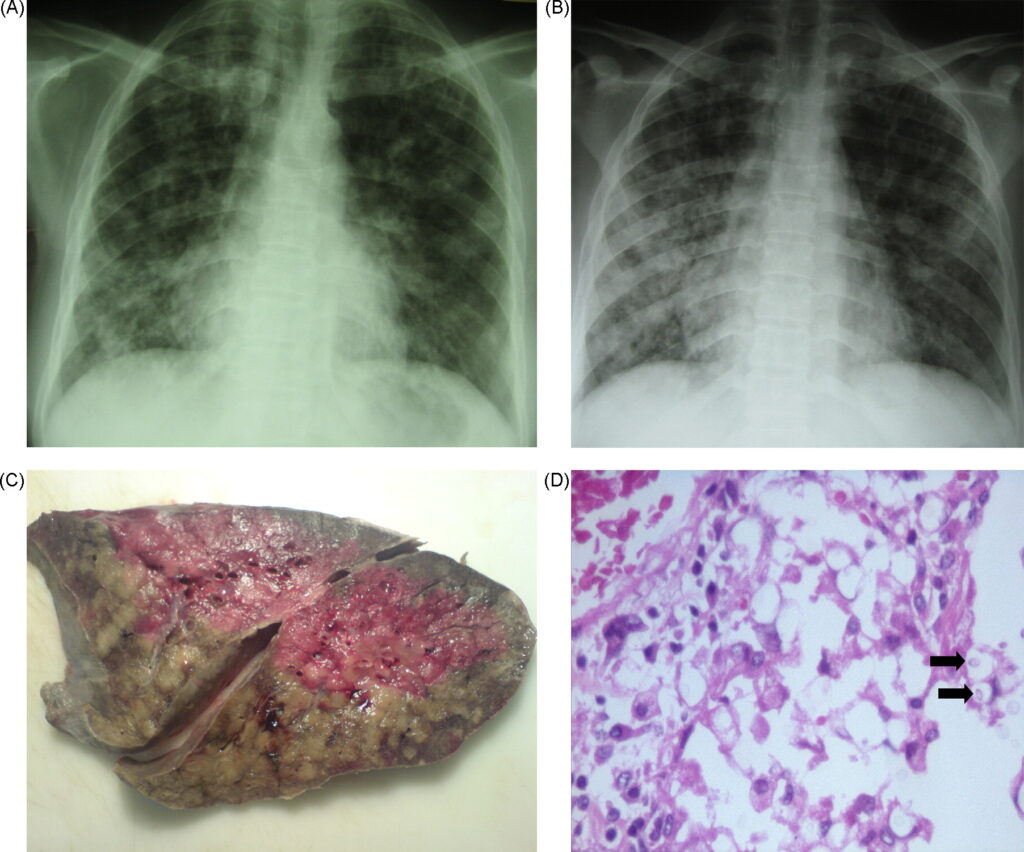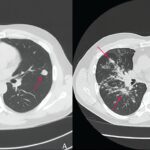Pulmonary cryptococcosis is a life-threatening fungal infection caused by the Cryptococcus species, most commonly Cryptococcus neoformans and Cryptococcus gattii. These fungi primarily affect the lungs, though they can disseminate to other organs such as the brain, particularly in individuals with weakened immune systems. Pulmonary cryptococcosis is a significant health concern due to its potential to cause severe respiratory issues, particularly in immunocompromised individuals. This article delves into the causes, symptoms, diagnosis, treatment options, and prevention strategies for pulmonary cryptococcosis.

What is Pulmonary Cryptococcosis?
Pulmonary cryptococcosis is a fungal infection that primarily affects the lungs. It is caused by inhaling Cryptococcus spores, which are found in the environment, especially in soil and bird droppings. While the infection is common in individuals with compromised immune systems, it can also affect healthy individuals. Pulmonary cryptococcosis can present as a mild illness or progress into more severe conditions, leading to complications such as respiratory failure and disseminated disease.
Cryptococcus Species Involved
The two most common species of Cryptococcus that cause pulmonary cryptococcosis are:
- Cryptococcus neoformans: This species is primarily responsible for infections in individuals with compromised immune systems, such as those living with HIV/AIDS.
- Cryptococcus gattii: Although less common, this species can infect healthy individuals and is often associated with tropical or subtropical environments.
Causes and Risk Factors
Pulmonary cryptococcosis is caused by the inhalation of airborne Cryptococcus spores. These spores are prevalent in environments where pigeon droppings or decaying organic matter are present. When spores are inhaled, they can settle in the lungs and trigger an infection.
1. Environmental Exposure
- Soil and Bird Droppings: The spores of Cryptococcus are commonly found in soil, particularly in areas where bird droppings are prevalent. Pigeons are especially associated with the spread of Cryptococcus neoformans.
- Decaying Wood: Cryptococcus gattii is typically found in decaying wood, especially in tropical or subtropical regions.
2. Risk Factors for Infection
While anyone exposed to the spores can develop pulmonary cryptococcosis, certain factors increase the likelihood of infection:
- Immunocompromised Individuals: People with weakened immune systems, such as those with HIV/AIDS, cancer, or those on immunosuppressive drugs, are at higher risk.
- Chronic Lung Disease: Individuals with conditions such as chronic obstructive pulmonary disease (COPD) may be more susceptible to respiratory infections, including fungal diseases.
- Transplant Recipients: Organ transplant recipients, particularly those receiving lung or kidney transplants, are at a higher risk due to their immune-suppressing medications.
- Healthy Individuals: Although less common, Cryptococcus can also infect healthy individuals, particularly in the case of Cryptococcus gattii.
Symptoms of Pulmonary Cryptococcosis
The symptoms of pulmonary cryptococcosis can vary widely, from mild to severe, depending on the individual’s immune status and the extent of the infection. Common symptoms include:
1. Cough
A persistent cough, often dry, is one of the hallmark symptoms of pulmonary cryptococcosis. In severe cases, the cough may produce mucus or even blood.
2. Fever
Fever is a common response to fungal infections, and it often accompanies pulmonary cryptococcosis. The fever may be mild to moderate and is typically associated with chills.
3. Shortness of Breath
Individuals with pulmonary cryptococcosis often experience difficulty breathing, particularly with exertion. This symptom can worsen as the infection progresses.
4. Chest Pain
Chest pain, which may be sharp or dull, is another symptom that can arise in individuals with pulmonary cryptococcosis. This is often due to inflammation in the lung tissue caused by the infection.
5. Fatigue and Malaise
General fatigue, weakness, and malaise are common in individuals with pulmonary cryptococcosis, particularly when the infection is severe or prolonged.
6. Headache
In disseminated cases, where the infection spreads to the central nervous system (CNS), individuals may experience headache, confusion, and other neurological symptoms.
Diagnosis of Pulmonary Cryptococcosis
Diagnosing pulmonary cryptococcosis typically involves a combination of clinical evaluation, laboratory tests, and imaging studies. Given that the symptoms of cryptococcosis can resemble those of other respiratory infections, a definitive diagnosis requires specific diagnostic techniques.
1. Clinical Evaluation
The healthcare provider will start by assessing the patient’s medical history, including recent exposure to potential sources of Cryptococcus spores, and evaluating symptoms such as cough, fever, and shortness of breath.
2. Laboratory Tests
- Blood Tests: Blood tests can detect antibodies or antigens produced in response to the infection. A cryptococcal antigen test is a commonly used method for diagnosing cryptococcosis.
- Sputum Culture: A sample of sputum can be cultured to identify the Cryptococcus organism. However, cultures may take several days to yield results.
- Cerebrospinal Fluid (CSF) Analysis: If there is suspicion of disseminated disease, especially in the central nervous system, a lumbar puncture may be performed to examine CSF for cryptococcal cells or antigens.
3. Imaging Studies
- Chest X-ray: A chest X-ray may show signs of infection, such as lung consolidation, nodules, or infiltrates. However, the findings may not be specific to cryptococcosis.
- CT Scan: A high-resolution CT scan of the chest is more sensitive and can provide detailed images that reveal abnormalities such as lung nodules, cavities, or granulomas.
4. Biopsy
In some cases, a biopsy of lung tissue may be necessary to confirm the diagnosis. This is especially true in individuals who do not respond to initial treatments and in cases where there is uncertainty about the diagnosis.
Treatment of Pulmonary Cryptococcosis
The treatment of pulmonary cryptococcosis primarily involves antifungal medications. The course of treatment depends on the severity of the infection and the patient’s immune status.
1. Antifungal Medications
- Fluconazole: Fluconazole is the most commonly used antifungal for treating pulmonary cryptococcosis. It is typically prescribed for mild to moderate cases and may be used for extended periods to prevent relapse.
- Itraconazole: This antifungal may also be used in some cases, particularly if fluconazole is ineffective or the infection is resistant.
- Amphotericin B: For severe or disseminated cases of cryptococcosis, particularly in immunocompromised patients, amphotericin B may be required. This powerful antifungal is often administered intravenously.
2. Supportive Care
In addition to antifungal therapy, supportive care may be needed to manage symptoms and complications, such as oxygen therapy for individuals with respiratory distress.
3. Monitoring and Follow-up
Given the potential for relapse, particularly in individuals with weakened immune systems, ongoing monitoring and follow-up care are essential to ensure the infection is fully resolved.
Prevention of Pulmonary Cryptococcosis
Preventing pulmonary cryptococcosis involves reducing exposure to the Cryptococcus fungi and managing risk factors that predispose individuals to infection.
1. Limit Exposure to Bird Droppings
Individuals living in areas where pigeons or other birds congregate should avoid exposure to bird droppings, as these are a common source of Cryptococcus spores. Proper cleaning and use of protective equipment when working in environments with bird droppings can reduce the risk of infection.
2. Immunocompromised Individuals
For individuals with weakened immune systems, such as those with HIV/AIDS, cancer, or transplant recipients, it is important to follow guidelines for avoiding fungal infections. Prophylactic antifungal treatments may be recommended for high-risk individuals in endemic areas.
3. Environmental Control
In areas where Cryptococcus is prevalent, controlling the environment by reducing dust exposure and ensuring proper sanitation in living areas can help prevent infection.
Pulmonary cryptococcosis is a serious fungal infection that primarily affects the lungs but can spread to other organs, particularly in immunocompromised individuals. Early detection through proper diagnostic testing, followed by effective antifungal treatment, is essential to managing the infection and preventing complications. Awareness of risk factors and preventive measures, particularly for those in endemic areas or with weakened immune systems, plays a critical role in reducing the incidence of pulmonary cryptococcosis.

